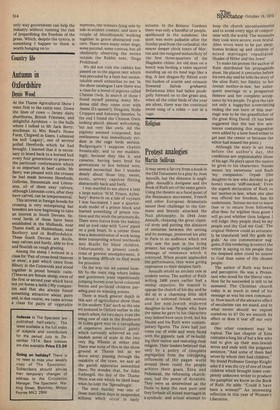Religion
Protest analogies
Martin Sullivan
It may seem a far cry from a book in the Old Testament to a play by Jean Anouilh, but the distance is negligible. Anouilh's Antigone and the Book of Ruth are of the same genre. Using the theatre as a focal point of the Resistance movement, French and other European dramatists issued their challenge to the Germans and bravely attacked the Nazi philosophy. In 1944 Jean Anouilh, choosing the great classical story and putting the distance of centuries between the setting and its message, presented his play in Paris to an audience which not only saw the past in the living present, but eagerly supported the message of resistance which it conveyed. When people applauded the performance, they were giving expression to their deepest faith.
Anouilh retold an ancient tale in modern terms. The author of Ruth writing 2400 years earlier had a similar objective. He wanted to oppose the church of his day and he did so in a charming little idyll about a widowed Jewish woman and her non-Jewish widowed daughter-in-law. People who bore the name he gave to his characters may indeed have once lived, but his Naomi and his Ruth were contemporary figures. The Jews had just come out of exile and were faced with the gigantic task of re-building their nation and restoring their religion. 'their leaders believed that only by a policy of complete segregation from the corrupting influences of the pagan world around them could the people achieve their goals. Ezra and Nehemiah, the reforming churchmen, had the power of dictators. They were as determined as the Nazis to keep the race pure and they forbade all mixed marriages in a symbolic and actual attempt to keep the church uncontaminated and to avoid every sign of compro
mise with the world. The measures they took were severe, even brutal. Alien wives were to be put away, homes broken up and children of mixed marriages repudiated. Shades of Hitler and the Jews!
To make his protest the author of Ruth distributed his propaganda sheet. He placed it centuries before his own day and he tells the story of the alien Ruth, her fidelity to her Jewish mother-in-law, her subsequent marriage to a prosperous Hebrew and her complete acceptance by his people. To give the tale not only a happy but a convincing ending the son born of this marriage was to be the grandfather of the great King David. (It has been suggested that the last few sentences containing this suggestion were added by a later hand either to get past the censor or because the editor had missed the point.) Although the story is set long before the author's day, the conditions are unmistakably those of his age. He plays upon the names he gives to his characters: Naomi means 'my sweetness' and Ruth 'my companion.' Orpah (the daughter-in-law who decided to go home) means 'stiff-necked.' Even the superb declaration of Ruth to her mother-in-law, when she also was offered her freedom, has its undertones. 'Intreat me not to leave thee or to return from following after thee: for whither thou goest I will go and whither thou lodgest I will lodge; they people shall be my people and thy God my God.' The original Hebrew could as accurately be translated 'and thy gods my gods.' • As one commentator suggests, if this rendering is correct the writer is saying to his people that the despised alien could be nearer to God than some of His chosen people.
The author of Ruth was brave and perceptive. He was a Protestant who stood for the liberal view. How far he succeeded is still to be assessed. The Christian church today is as much in need of his message as was his own community. How much of the abrasive effect of secularism can we stand, and to what extent should we expose ourselves to it? Do we smooth its effect or does it tear off our very skin?
One other comment may be topical. The last chapter of Ezra contains a long list of but a few who had to give up their non-Jewish wives and ends with the poignant sentence, "And some of them had wives by whom they had children." My friend Professor George Knight asks if it was the cry of one of those children which brought some completely unknown writer to produce the pamphlet we know as the Book of Ruth. He adds: "Could it have been a woman?" An interesting reflection in this year of Women's Liberation.


































 Previous page
Previous page